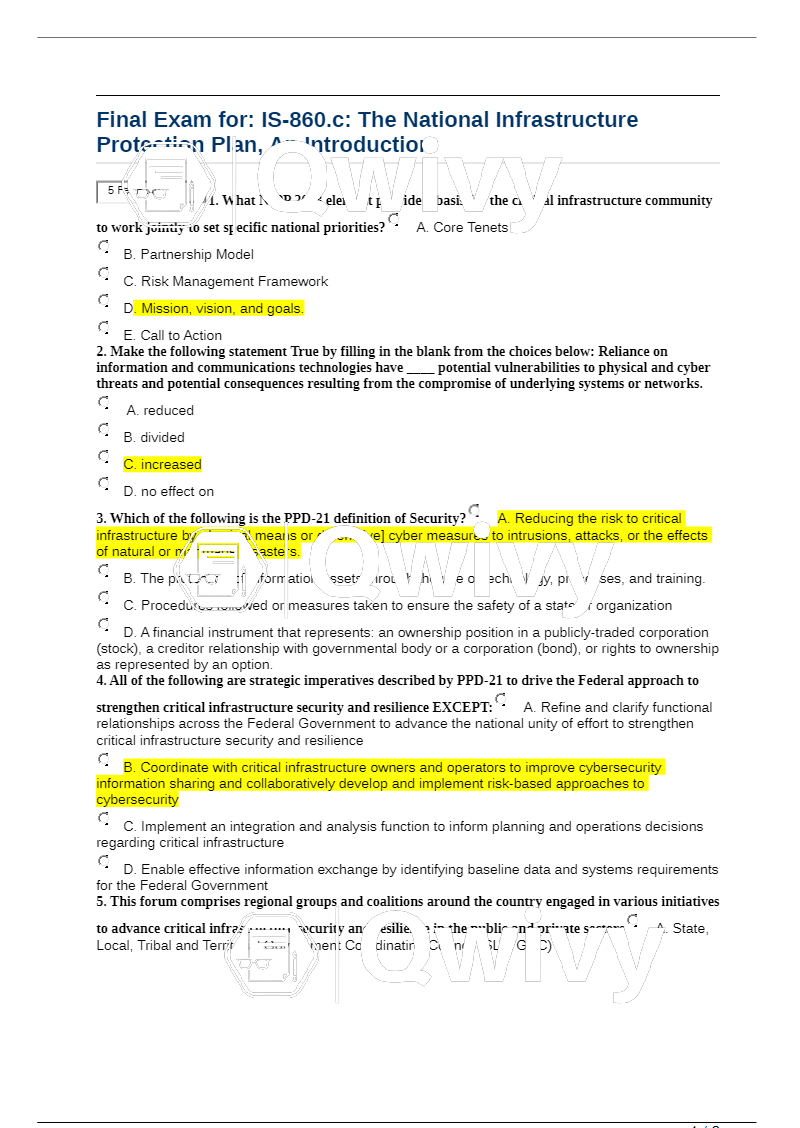
Final Exam for: IS-860.c: The National Infrastructure
Protection Plan, An Introduction
1. What NIPP 2013 element provide a basis for the critical infrastructure community
to work jointly to set specific national priorities? A. Core Tenets
B. Partnership Model
C. Risk Management Framework
D. Mission, vision, and goals.
E. Call to Action
2. Make the following statement True by filling in the blank from the choices below: Reliance on
information and communications technologies have ____ potential vulnerabilities to physical and cyber
threats and potential consequences resulting from the compromise of underlying systems or networks.
A. reduced
B. divided
C. increased
D. no effect on
3. Which of the following is the PPD-21 definition of Security? A. Reducing the risk to critical
infrastructure by physical means or defens[ive] cyber measures to intrusions, attacks, or the effects
of natural or manmade disasters.
B. The protection of information assets through the use of technology, processes, and training.
C. Procedures followed or measures taken to ensure the safety of a state or organization
D. A financial instrument that represents: an ownership position in a publicly-traded corporation
(stock), a creditor relationship with governmental body or a corporation (bond), or rights to ownership
as represented by an option.
4. All of the following are strategic imperatives described by PPD-21 to drive the Federal approach to
strengthen critical infrastructure security and resilience EXCEPT: A. Refine and clarify functional
relationships across the Federal Government to advance the national unity of effort to strengthen
critical infrastructure security and resilience
B. Coordinate with critical infrastructure owners and operators to improve cybersecurity
information sharing and collaboratively develop and implement risk-based approaches to
cybersecurity
C. Implement an integration and analysis function to inform planning and operations decisions
regarding critical infrastructure
D. Enable effective information exchange by identifying baseline data and systems requirements
for the Federal Government
5. This forum comprises regional groups and coalitions around the country engaged in various initiatives
to advance critical infrastructure security and resilience in the public and private sectors A. State,
Local, Tribal and Territorial Government Coordinating Council (SLTTGCC)
5 Per Page
1 / 2
B. Regional Consortium Coordinating Council (RC3)
C. Federal Senior Leadership Council (FSLC)
D. Sector Coordinating Councils (SCC)
6. Under which category in the NIPP Call to action does the following activity fall: Learn and Adapt
During and After Exercises and Incidents A. Build Upon Partnership Efforts
B. Focus on Outcomes
C. Innovate in Managing Risk
7. PPD-21 recommends critical infrastructure owners and operators contribute to national critical
infrastructure security and resilience efforts through a range of activities, including all of the following
EXCEPT: A. Perform critical infrastructure risk assessments; understand dependencies and
interdependencies; and develop emergency response plans
B. Sponsor critical infrastructure security and resilience-related research and development,
demonstration projects, and pilot programs
C. Develop and coordinate emergency response plans with appropriate Federal and SLTT
government authorities
D. Establish continuity plans and programs that facilitate the performance of lifeline functions
during an incident
8. This forum promotes the engagement of non-Federal government partners in National critical
infrastructure security and resilience efforts and provides an organizational structure to coordinate
across jurisdictions on State and local government guidance, strategies and programs. A. State,
Local, Tribal and Territorial Government Coordinating Council (SLTTGCC)
B. Regional Consortium Coordinating Council (RC3)
C. Federal Senior Leadership Council (FSLC)
D. Sector Coordinating Councils (SCC)
9. For what group of stakeholders are the following examples of activities suggested: Become involved in
a relevant local, regional sector and cross-sector partnership; Work with private sector and emergency
response partners on emergency management plans and exercising; Share success stories and
opportunities for improvement. A. State, Local, Tribal, and Territorial Government Executives
B. Private Sector Companies
C. First Responders
D. All of the Above
10. Which of the following critical infrastructure partners offer an additional mechanism to engage with
a pre-existing group of private sector leaders to obtain feedback on critical infrastructure policy and
programs, and to make suggestions to increase the efficiency and effectiveness of specific government
programs. A. Federal and State Regulatory Agencies
B. State and Regionally Based Boards, Commissions, Authorities, Councils, and Other Entities
C. Academia and Research Centers
D. Advisory Councils
Powered by qwivy(www.qwivy.org)
2 / 2
| Version | latest |
| Category | Exam (elaborations) |
| Authors | qwivy.com |
| Pages | 11 |
| Language | English |
| Comments | 0 |
| Sales | 1 |






{{ userMessage }}





